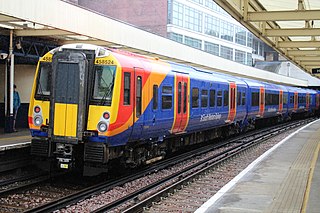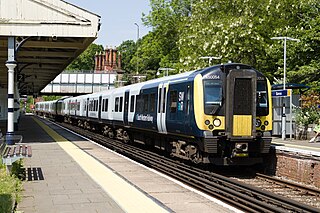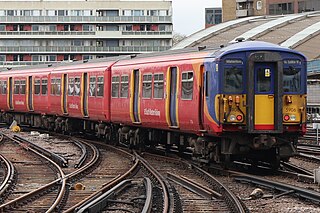
The British RailClass 411 (4CEP) electric multiple units were built at Eastleigh works from 1956–63 for the newly electrified main lines in Kent. These units, which used the British Railways Mark 1 bodyshell, were based on the earlier Southern Railway 4 COR design, built in 1937. Variants of the class 411 design included the class 410 and class 412 4 BEP units, which contained a buffet car in place of a standard trailer. They were later used on services in Sussex and Hampshire; following the privatisation of British Rail in 1995, the units were used by the Connex South Central, Connex South Eastern and South West Trains franchises. They were replaced by Juniper, Desiro, and Electrostar units. The fleet's lifespan was 49 years. These units are the longest-lived BR Mark 1 EMUs.

The British Rail Class 159 is a class of British diesel multiple unit passenger trains of the Sprinter family, built in 1989–1992 by British Rail Engineering Limited (BREL)'s Derby Litchurch Lane Works as Class 158. Before entering traffic, the original 22 units were modified at Rosyth Dockyard to Class 159 to operate services from London Waterloo to Salisbury and Exeter St Davids, replacing various locomotive-hauled passenger trains.

Winchester railway station serves the city of Winchester, in the county of Hampshire, England. It is a stop on the South West Main Line and was known as Winchester City from 1949–67, to distinguish it from Winchester (Chesil) station. It is 66 miles 39 chains (107.0 km) down the line from London Waterloo.

The British Rail Class 456 was an electric multiple unit passenger train introduced by Network SouthEast on inner-suburban services in South London to replace the elderly Class 416 2EPB units. Twenty-four two-car units were built by British Rail Engineering Limited's York Carriage Works in 1990 and 1991.

The British Rail Class 458 Juniper (5-JUP) is a class of electric multiple-unit passenger trains of the Alstom Coradia Juniper family, built at Washwood Heath between 1998 and 2002 for South West Trains. The order for the original fleet of 30 four-car trains was placed in 1997, and delivery of the first unit followed in October 1998. The fleet entered passenger service between 2000 and 2003 and is maintained at Bournemouth depot.

The British Rail Class 450 Desiro are third-rail DC electric multiple unit (EMU) passenger trains that entered service during 2003. Used for outer-suburban services, they were built with both first- and standard-class accommodation. They have a maximum speed of 100 mph (160 km/h).

The British Rail Class 442 (5-WES) Wessex Electrics were electric multiple unit passenger trains introduced in 1988 by Network SouthEast on the South West Main Line from London Waterloo to Weymouth to coincide with the electrification of the line from Bournemouth. Twenty-four five-car units were built by British Rail Engineering Limited's Derby Litchurch Lane Works.

The British Rail Class 444 Desiro is an electric multiple-unit passenger train built by Siemens Transportation Systems in Austria between 2002 and 2004. The Class 444 currently operate on express passenger services for South Western Railway.

Guildford railway station is at one of three main railway junctions on the Portsmouth Direct Line and serves the town of Guildford in Surrey, England. It is 30 miles 27 chains down the line from London Waterloo via Woking.

The Sutton and Mole Valley lines were constructed between 1847 and 1868 by the London, Brighton and South Coast Railway, the London and South Western Railway and the LBSCR-sponsored Horsham, Dorking and Leatherhead Railway.

Aldershot railway station is located near the town centre of Aldershot in Hampshire, England. It is 35 miles (56 km) down the line from London Waterloo. It is on the Alton Line, part of the National Rail network, with train services and station facilities provided by South Western Railway.

The Alton line is a railway line in Hampshire and Surrey, England, operated by South Western Railway; it is a relatively long branch of the South West Main Line.

Woking railway station is a major stop in the town of Woking in England, on the South West Main Line used by many commuters. It is 24 miles 27 chains (39.2 km) down the line from London Waterloo. The station is managed by South Western Railway, who operate all trains serving it.

The British Rail Class 455 is an electric multiple unit passenger train built by BREL between 1982 and 1985. It is operated on suburban services in Greater London and Surrey by South Western Railway, as well as formerly by Southern.

Portsmouth Harbour railway station serves the city of Portsmouth, in Hampshire, England. It is situated in Portsmouth Harbour, between the Gunwharf Quays shopping centre and the Historic Dockyard. It is an important transport terminal, with a bus interchange and ferry services to Gosport and the Isle of Wight. Unusually for a main line railway station, it is built over water as the station was originally constructed on wooden piles, which were later replaced by iron supports.

Bedhampton railway station serves the former village of Bedhampton, now a suburb lying a mile west of the centre of Havant, in Hampshire, England.
The Southern Region was a region of British Railways from 1948 until 1992 when railways were re-privatised. The region ceased to be an operating unit in its own right in the 1980s. The region covered south London, southern England and the south coast, including the busy commuter belt areas of Kent, Sussex and Surrey. The region was largely based upon the former Southern Railway area.

Island Line is a brand of South Western Railway which runs the 8.5-mile (13.7 km) Island Line on the Isle of Wight. A stand-alone franchise from 1996 until 2007, it then became part of the South Western franchise operated by South West Trains until August 2017 and since by South Western Railway.

The British Rail Class 707 is an electric multiple unit passenger train built by Siemens Mobility on its Desiro City platform, and operated in England by Southeastern. The units were previously operated by South Western Railway.

South Western Railway is a British train operating company owned by FirstGroup (70%) and MTR Corporation (30%) that operates the South Western franchise.





















































